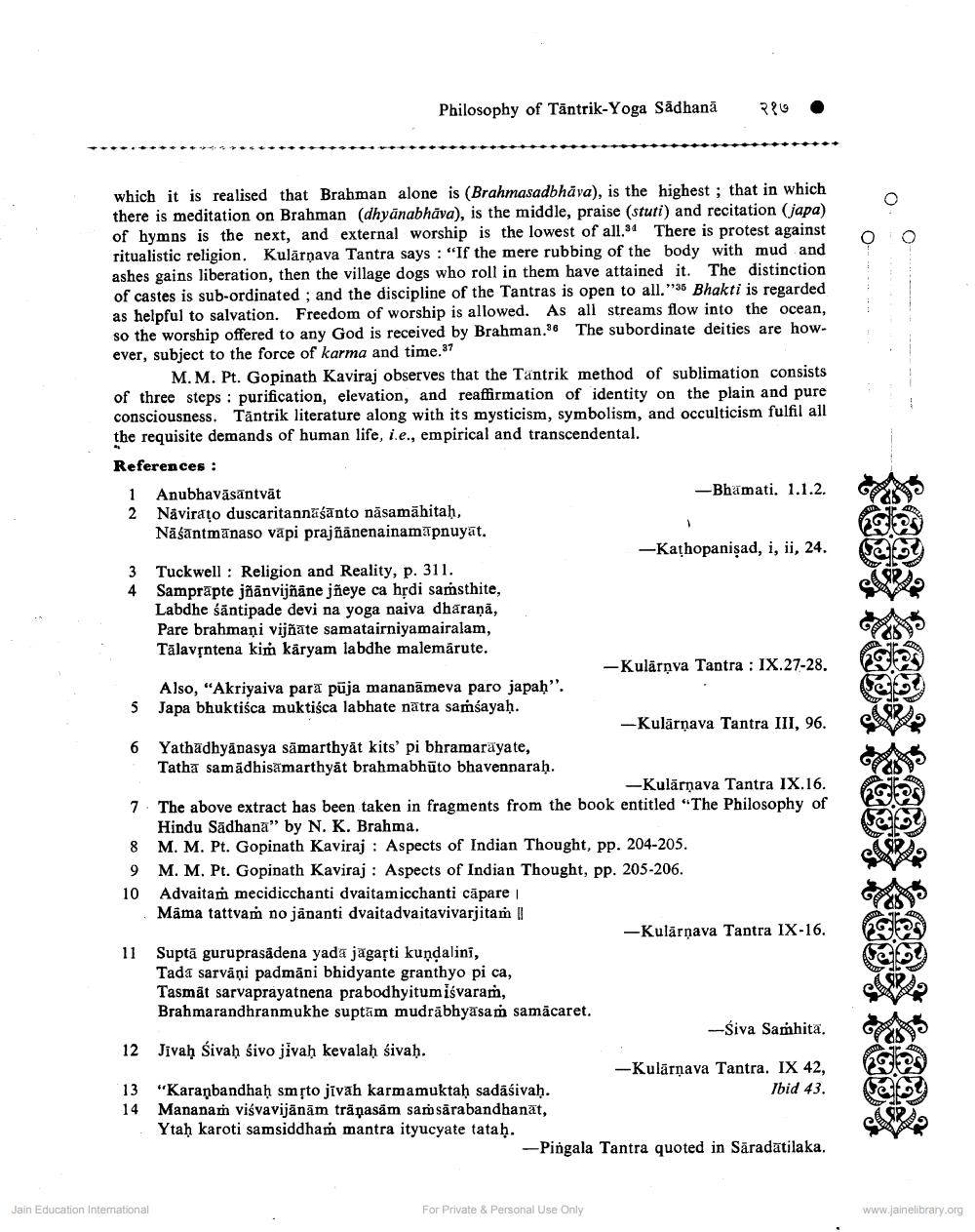________________
Philosophy of Tantrik-Yoga Sadhanā
which it is realised that Brahman alone is (Brahmasadbhava), is the highest; that in which there is meditation on Brahman (dhyanabhava), is the middle, praise (stuti) and recitation (japa) of hymns is the next, and external worship is the lowest of all.34 There is protest against ritualistic religion. Kulārṇava Tantra says: "If the mere rubbing of the body with mud and ashes gains liberation, then the village dogs who roll in them have attained it. The distinction of castes is sub-ordinated; and the discipline of the Tantras is open to all."3 Bhakti is regarded as helpful to salvation. Freedom of worship is allowed. As all streams flow into the ocean, so the worship offered to any God is received by Brahman. The subordinate deities are however, subject to the force of karma and time.37
References :
M. M. Pt. Gopinath Kaviraj observes that the Tantrik method of sublimation consists of three steps: purification, elevation, and reaffirmation of identity on the plain and pure consciousness. Tantrik literature along with its mysticism, symbolism, and occulticism fulfil all the requisite demands of human life, i.e., empirical and transcendental.
1 Anubhavāsantvät
2 Navirato duscaritannāśanto näsamāhitaḥ, Nāśantmanaso vapi prajñānenainamapnuyāt.
3 Tuckwell: Religion and Reality, p. 311. 4 Sampräpte jñānvijñāne jñeye ca hrdi samsthite, Labdhe śantipade devi na yoga naiva dharaṇā, Pare brahmani vijñāte samatairniyamairalam, Tālavṛntena kim karyam labdhe malemärute.
Also, "Akriyaiva para pūja mananāmeva paro japaḥ". 5 Japa bhuktiśca muktiśca labhate natra samsayaḥ.
6 Yathadhyānasya samarthyāt kits' pi bhramarayate, Tatha samadhisämarthyāt brahmabhūto bhavennaraḥ.
Jain Education International
२१७ ●
Advaitam mecidicchanti dvaitamicchanti căpare | Mama tattvam no jānanti dvaitadvaitavivarjitam ||
11 Supta guruprasadena yada jägaṛrti kundalini,
Tada sarvāņi padmani bhidyante granthyo pi ca, Tasmat sarvaprayatnena prabodhyitumisvaram, Brahmarandhranmukhe suptām mudrabhyasam samācaret.
12 Jivaḥ Śivaḥ śivo jivaḥ kevalaḥ śivaḥ.
13 "Karanbandhaḥ smrto jivah karmamuktaḥ sadāśivaḥ. 14 Mananam viśvavijānām trāpasam sam sārabandhanāt, Ytaḥ karoti samsiddham mantra ityucyate tataḥ.
-Bhamati. 1.1.2.
-Kulārṇava Tantra IX.16.
7 The above extract has been taken in fragments from the book entitled "The Philosophy of Hindu Sadhana" by N. K. Brahma.
8 M. M. Pt. Gopinath Kaviraj : Aspects of Indian Thought, pp. 204-205.
9
M. M. Pt. Gopinath Kaviraj : Aspects of Indian Thought, pp. 205-206.
10
For Private & Personal Use Only
-Kathopanisad, i, ii, 24.
-Kulārṇva Tantra: IX.27-28.
-Kulārṇava Tantra III, 96.
-Kulārṇava Tantra IX-16.
-Śiva Samhita.
-Kulārṇava Tantra. IX 42, Ibid 43.
-Pingala Tantra quoted in Sāradatilaka.
CARI
CELERA
www.jainelibrary.org




